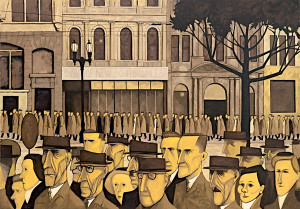Creatively exploring migrant and refugee experience
Migrant and refugee issues are plastered across Australian headlines every day, but compared to their prominence in our society they are rarely depicted in creative mediums.
Feature films, novels and fine art have the ability to make an issue feel truly realistic and relatable in a way that can inspire the viewer to learn more and take action in the real world.
Throughout Australia’s creative history however, migrant and refugee issues remain relatively absent.
Due to the ‘othering’ effect of the media when covering migrants and refugees, creative mediums are desperately needed to humanise the refugee debate and transform the Australian public into understanding the stories of the world’s most vulnerable.
Being that this is considered ‘the age of migration’, it seems strange that the many issues explored through creative pursuits are rarely that of refugees.
While there are various series and film length documentaries that discuss both the unimaginable journey to Australian shores and life once having reached ‘safety’, fiction provides emotional connections and insights that documentaries fall short on.
Australia’s most notable cinematic experience about asylum seekers is the 2007 feature length film ‘Lucky Mile’.
The film follows two asylum seekers and one of the people smugglers they were duped by as they walk through the harsh Western Australian desert together.
While inspired by several true stories, the film never feels like a doco, through focusing on comedy as well as using the landscape to emphasise the plight of the men.
The lack of good or bad guys and injection of comedy into an issue that’s usually only discussed politically emphasises the humanity of the situation and creates relatability through entertainment.
While the film acknowledges the political realities of today, the protagonists are neither condescended to nor glorified, and therefore allows the viewer to walk countless kilometres in the shoes of the asylum seekers behind the headlines.
Iconic comic novel ‘They’re a Weird Mob’ also employs humour to create an entertaining and relatable story, though it does this through exploring the journey of an Italian migrant settling into Australian culture.
Written by John O’Grady under the pseudonym ‘Nina Culotta’, the name of the main character in the book, the novel is a social commentary on 1950s working class society in Australia.
While the overarching message is that migrants should consider themselves lucky to live in Australia, there is also a satirical undercurrent that points out how Australians seem to forget how their country is indeed a country of migrants.
The huge success of the novel conveyed Australians ability to see a clear reflection of themselves in the commentaries, and led to it being turned into a film in 1966.
While film and novels make audiences understand issues through relating to characters, fine art is more immediate in how it must make the viewer understand an issue being explored.
John Brack, one of Australia’s leading modern artists, produced the painting ‘Collins St, 5p.m.’ as what could be read as a commentary on the lack of cultural diversity in Australia during the 1950s due to the White Australia Policy.
As Melbourne’s population was predominantly Anglo-Celtic in origin, the painting reflects this by showing a mass of almost identical people that have just finished work, painted monochromatically to visually express this sameness.
Though the 1950s migration transformed Australia, migrants primarily came from continental Europe and Britain, with non-white people being prohibited from migration based on fears of uneasy assimilation and cheap labour.
‘Collin St, 5p.m.’ immediately affects the reader with a sense of lack of individuality in a miserable and tragic way, conveying how the loss of cultural diversity promotes bleakness.
The painting was at the time, and still is, heralded as a highly perceptive social commentary on daily life that immediately impacts the viewer.
A call for more coverage of these issues in creative mediums is needed because through exploring the journey of refugees and the migrant experience, film, fiction and fine art have the potential to make the audience deeply understand issues that are often left at the surface.
Ruby Brown
AMES Australia Staff Writer













